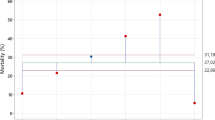Abstract
The insecticidal efficacy of the diatomaceous earth formulation DiatoSec® (Ediafilt Diatomite Mining and Processing Ltd., Hungary) against the granary weevil, Sitophilus granarius (Coleoptera: Curculionidae), was evaluated on maize and barley grain in laboratory tests. The diatomaceous earth formulation was applied at three doses of 1, 2 and 4 g kg-1of both grain types. Mortality of S. granarius adults was estimated after 24 and 48 h and 7, 14 and 21 d of exposure on treated grain. After the 21 d counts, all the exposed adults were removed and progeny production on treated grains was assessed 45 days later.
The insecticidal efficacy of the examined diatomaceous earth against the granary weevil was highly influenced by grain type, exposure time and dose. The longer exposure times increased weevil mortality in the case of both grains. The efficacy on maize was unsatisfactory. On the other hand, 85% of the weevils were died after a 21 d exposure on barley treated with the highest dose. In addition, progeny production on treated barley was completely suppressed. In all, a satisfactory level of protection was only achieved with barley at a rate of 4 g kg−1. Differences in efficacy between grain types could be traced back to differences in grain surface. The lower efficacy — than some examined silica products — of DiatoSec as compared to similar products can be explained by the lower SiO2 content.
Similar content being viewed by others
References
Abbott WS, 1925. A method of computing the effectiveness of an insecticide. J Econ Entomol 8, 265–267.
Aldryhim YM, 1993. Combination of classes of wheat and environmental factors affecting the efficacy of amorphous silica dust, Dryacide®, against Rhyzopertha dominica (F.). J Stored Prod Res 29, 271–275.
Athanassiou CG, Kavallieratos NG, Tsaganou FC, Vayias BJ, Dimizas CB & Buchelos CT, 2003. Effect of grain type on the insecticidal efficacy of SilicoSec against Sitophilus oryzae(L.) (Coleoptera: Curculionidae). Crop Prot 22, 1141–1147.
Athanassiou CG, Vayias BJ, Dimizas CB, Kavallieratos NG, Papagregoriou AS & Buchelos CT, 2005. Insecticidal efficacy of diatomacous earth against Sitophilus oryzae (L.) (Coleoptera: Curculionidae) and Tribolium confusum DuVal (Coleoptera: Tenebrionidae) on stored wheat: influence of dose rate, temperature and exposure interval. J Stored Prod Res 41, 47–55.
Arthur FH, 1996. Grain protectants: current status and prospects for the future. J Stored Prod Res 32, 293–302.
Arthur FH, 2002. Survival of Sitophilus oryzae (L.) (Coleoptera: Curculionidae) on wheat treated with diatomaceous earth: impact of biological and environmental parameters on product efficacy. J Stored Prod Res 38, 305–313.
Demissie G, Tefera T & Tadesse A, 2008. Efficacy of Silicosec, filter cake and wood ash against the maize weevil, Sitophilus zeamais Motschulsky (Coleoptera: Curculionidae) on three maize genotypes. J Stored Prod Res 44, 227–231.
Erb-Brinkmann M, 2000. Application of amorphous silica dust (SilicoSec®) in Germany — practical experiences. Integr Prot Stored Prod 2, 239–242.
Fava A & Burlando B, 1995. Influence of female age and grain availability on the ovipositional pattern of the wheat weevil Sitophilus granarius (Coleoptera, Curculionidae). Eur J Entomol 92, 421–425.
Fields P & Korunic Z, 2000. The effect of grain moisture content and temperature on the efficiacy of diatomaceaus earth from different geographical locations against stored-product beetles. J Stored Prod Res 36, 1–36.
Golob P, 1997. Current status and future perspectives for inert dusts for control of stored product insects. J Stored Prod Res 33, 69–79.
Jávor I, 1990. Granary weevil (Sitophilus granaries L.). In: T. Jermy & K. Balázs (eds.): Handbook of practical plant protection 3/B. First edition, pp. 486–491. Academic Press, Budapest, Hungary. (in Hungarian, translated by authors)
Korunic Z, 1998. Diatomaceous earth, a group of natural insecticides. J Stored Prod Res 34, 87–97.
Korunic Z & Ormesher P, 2000. Evaluation and standardised testing of diatomaceous earth. In: Zuxun J, Quan L, Yongsheng L, Xianchiang T & Lianghua G, (Eds) 2000: Proceedings 7th International Working Conference on Stored-Product Protection. Sichuan Publishing House of Science and Technology, Chengdu, China. 738–744.
Korunic Z, Fields PG, Kovacs MIP, Noll JS, Lukow OM, Demianyk CJ & Shibley KJ, 1996. The effect of diatomaceous earth on grain quality. Postharvest Biol Tec 9, 373–387.
LaHue DW, 1972. The retention of diatomaceous earth and silica aerogels on shelled corn, hard winter wheat, and sorghum grain. Agricultural Research Service, United States Department of Agriculture, ARS 51044, 8pp
McDonald J, 1986. Diatomaceous earth: a non toxic pesticide. Ecol Agric Proj 47, 14–42.
McGaughey WH, 1972. Diatomaceous earth for confused flour beetle and rice weevil control in rough, brown, and milled rice. J Econ Entomol 65, 1427–1428.
Mewis I & Ulrichs C, 2001. Action of amorphous diatomaceous earth against different stages of the stored product pest Tribolium confusum, Tenebrio molitor, Sitophilus granarius and Plodia interpunctella. J Stored Prod Res 37, 153–164.
Stejskal V & Kucerova Z, 1996. The effect of grain size on the biology of Sitophilus granarius L (Col, Curculionidae). 1. Oviposition, distribution of eggs and adult emergence. J Appl Entomol 120, 143–146.
Subramanyam BH & Roesli R, 2000. Inert dusts. In: Subramanyam BH & Hagstrum DW, (Eds.) 2000: Alternatives to pesticides in stored-product IPM. Kluwer Academic Publishers, Dordrecht, The Netherlands. 321–380.
Vayias BJ & Athanassiou CG, 2004. Factor affecting the insecticidal efficacy of the diatomaceous earth formulation SilicoSec against adults and larvae of the confused flour blee, Tribolium confusum DuVal (Coleoptera: Tenebrionidae). Crop Prot 23, 565–573.
Author information
Authors and Affiliations
Corresponding author
Rights and permissions
About this article
Cite this article
Keszthelyi, S., Pál-Fám, F. The effect of the diatomaceous earth formulation DiatoSec on mortality of granary weevil Sitophilus granarius (Coleoptera: Curculionidae) in grains. J Plant Dis Prot 119, 30–33 (2012). https://doi.org/10.1007/BF03356416
Received:
Accepted:
Published:
Issue Date:
DOI: https://doi.org/10.1007/BF03356416




